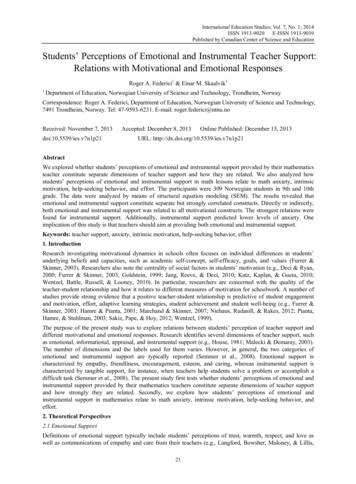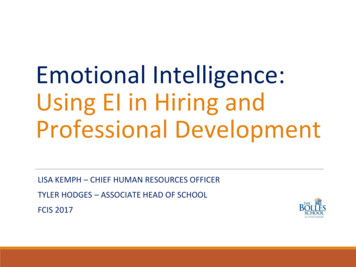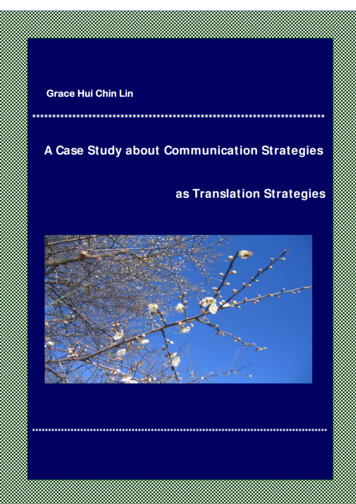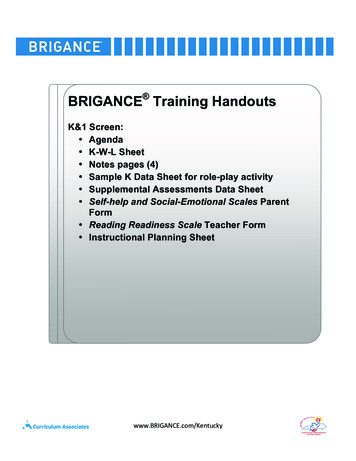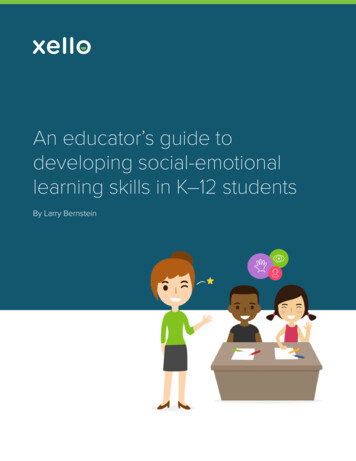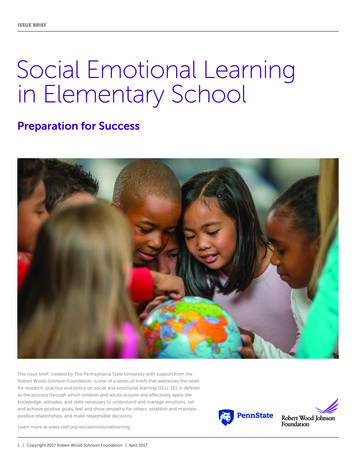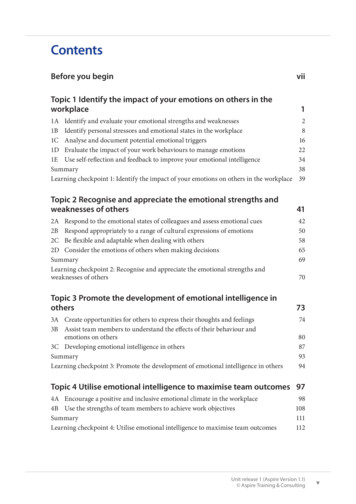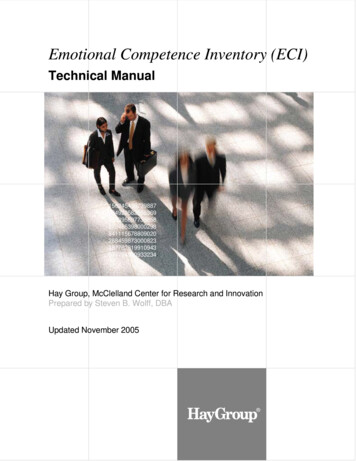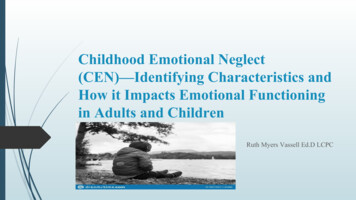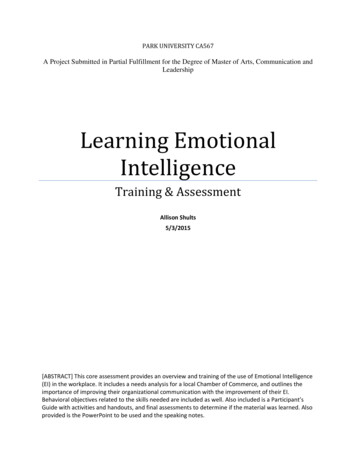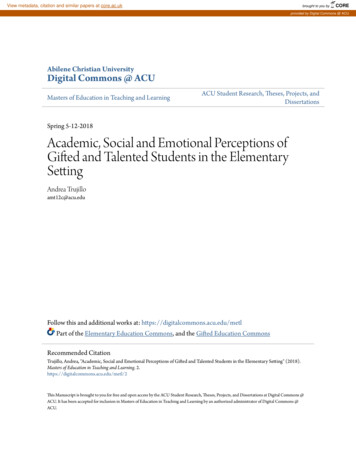
Transcription
View metadata, citation and similar papers at core.ac.ukbrought to you byCOREprovided by Digital Commons @ ACUAbilene Christian UniversityDigital Commons @ ACUMasters of Education in Teaching and LearningACU Student Research, Theses, Projects, andDissertationsSpring 5-12-2018Academic, Social and Emotional Perceptions ofGifted and Talented Students in the ElementarySettingAndrea Trujilloamt12c@acu.eduFollow this and additional works at: https://digitalcommons.acu.edu/metlPart of the Elementary Education Commons, and the Gifted Education CommonsRecommended CitationTrujillo, Andrea, "Academic, Social and Emotional Perceptions of Gifted and Talented Students in the Elementary Setting" (2018).Masters of Education in Teaching and Learning. 2.https://digitalcommons.acu.edu/metl/2This Manuscript is brought to you for free and open access by the ACU Student Research, Theses, Projects, and Dissertations at Digital Commons @ACU. It has been accepted for inclusion in Masters of Education in Teaching and Learning by an authorized administrator of Digital Commons @ACU.
Running head: Gifted Student Perceptions of School1Academic, Social and Emotional Perceptions of Gifted and Talented Students in the ElementarySettingAndrea TrujilloAbilene Christian University
GIFTED STUDENT PERCEPTIONS OF SCHOOL2AbstractResearch has been done comparing academic achievement of gifted students in diverseschool environments, but little has been found about their perceptions as learners in theseenvironments. The purpose of this action research study was to gain academic, social andemotional perceptions of six gifted and talented students in a self-contained elementaryclassroom. The author collected data through a perception survey, student and teacherinterviews, and teacher observations. After collecting data for four weeks and analyzing it usingthe constant comparative method, the author found that the GT students were challenged in math,extracurricular activities were their favorite, they displayed positive peer interactions, and theirperceptions of failure varied. This study will give insight to other educators about the perceptionsof GT students in the elementary school setting.
GIFTED STUDENT PERCEPTIONS OF SCHOOL3Academic, Social and Emotional Perceptions of Gifted and Talented Students in anElementary SettingThe answer to my curiosity to know what a GT (gifted and talented) students’ perceptionof school was came in a simple sentence which was said by Paige (all names are pseudonyms), aGT student who participated in my study. She said, “ challenging stuff is easy but, easy stuffin first grade is challenging to me.” This quote captured the overall perception of the gifted andtalented students in my class, and I used this thought to further explore what challenge meant tothese students and where they found challenge in the school setting. Educators and researchershave focused on the performance of gifted and talented students, but I sought to investigate theiracademic, social and emotional perceptions of school, how their perceptions differed betweenmale and female gifted learners, and how their perceptions impacted their learning.PurposeThe purpose of my study was to investigate the academic, social and emotionalperceptions of gifted and talented students about school, and whether or not they feel challengedin school. I wanted to investigate how GT students perceive the learning environment, and howthey see themselves and their peers (gifted and non-gifted) fitting into the school environment.My research questions for the study were as follows:What are the social, emotional and academic perceptions of a GT student concerning the learningenvironment? In what ways do GT boys and girls in my class perceive school differently? What is the perception of the GT teacher, my cooperating teacher, of the GT students andtheir overall performance in school?
GIFTED STUDENT PERCEPTIONS OF SCHOOL 4What are my perceptions of the GT students as I observe their academic, social andemotional influences?While I conducted this study, I was a graduate student completing a year-long clinicalteaching placement at Tucker Elementary in a second grade classroom. Tucker Elementary was aTitle 1 school part of Adams Independent School District serving approximately 550 students inkindergarten through fifth grade, almost 75% of whom were coded as economicallydisadvantaged.Related LiteratureResearch shows that some GT students have the social perception of either being an“insider” or “outsider” when it comes to their social life at school, and some try to cover up theirgifted identity by using negative coping strategies such as displaying negative behavior in ordernot to receive an “outsider” status (Eddles-Hirsch, Vialle, McCormick, & Rogers, 2012).Furthermore, there are also gender expectations that gifted learners have given themselves asdescribed by Eddles-Hirsh et al. (2012). Males tend to want the athletic label over the academiclabel because athleticism is perceived as a masculine identity by most male peers, whereasfemales usually care about their academic identity and like to be perceived as a gifted learner.These findings coincide with Berlin’s (2009) study on the stereotypes that are placed ongifted students. Berlin (2009) concluded that the negative stereotypes of gifted students usuallycome from classmates or others who do not know the students personally. In the same study, shefound that gifted students actually had more positive perceptions of themselves linked to selfconfidence, and that they valued greater academic opportunities and challenges. Others arguethat gifted students who are not performing to their potential are not underachieving, as somewill call it, but rather they are under-challenged (Winebrenner & Brulles, 2012). The balance
GIFTED STUDENT PERCEPTIONS OF SCHOOL5between self-confidence and the appropriate learning challenge is key in motivating giftedlearners and cultivating positive perceptions of themselves.A cluster grouping study conducted by Brulles, Saunders and Cohn (2010) revealed thatGT students who were put in a cluster class with students who have similar academic abilitiesand a GT trained teacher perform at higher academic levels than GT students who aremainstreamed into general education classrooms. The researchers concluded that the studentsperformed higher due to the level of differentiation since gifted learners were the teacher’s mainfocus. Clustering students by ability slightly narrows the learning gap within the classroom andallows for more flexible and effective instruction as the researchers found.A similar cluster model study done by Eddles-Hirsh et al. (2012) revealed how GTstudents navigated two school environments. In one environment, the students were grouped intoGT clusters, researchers noticed that the students in the cluster classroom perceived the learningenvironment as label-free and felt safe to learn without a stigma. Likewise, in a study conductedby Vidergor and Gordon (2015), researchers found that self-contained classrooms of giftedstudents do cater to their needs according to the students, teachers, and parents interviewed in thestudy. However, others have perceived this ability grouping to be detrimental because studentsbegin to compete with one another (Eddles-Hirsh et al., 2012). In the second environment, thestudents were randomly placed in classrooms with a variety of student abilities. When thestudents were asked how they felt about being placed with a mixed-ability group of peers,answers varied. Some gifted students said they liked the heterogeneous classroom because theymissed interacting with their non-gifted friends when they were in the GT class. However, otherssaid they felt pressure to fit in because they were perceived as the “smart kid” by their peers,
GIFTED STUDENT PERCEPTIONS OF SCHOOL6putting pressure on the students to hide their academic label in exchange for more equal socialinteractions with peers.In their book, Berliner and Glass (2014) identified some myths about “tracking” orgrouping students into classrooms according to ability. They found that low-achieving studentssuffer from this type of grouping while high-achieving students showed no profound academic orsocial gain. This difference was due to the fact that many of the students in the gifted programswere being “tracked” on more than just ability, but on race and socioeconomic status as well.Berliner and Glass (2014) concluded that grouping students by ability level robs them ofinteracting and learning from peers with diverse backgrounds.Differentiation is defined as the match of curriculum to a learner’s needs based on theircognitive level and experiences (Roberts & Inman, 2015). Roberts and Inman (2015) explain thateach student should be on a journey of continuous academic progress according to his or herneeds. Furthermore, in a study done by Piske et al. (2017), the researchers suggest that allowinggifted students the opportunity to create and have an innovative mindset can transform theirperceptions of school when it may seem redundant to learn content they have already mastered.De Corte (2013) also emphasized in his research that learning is constructive and self-regulated.In other words, students have to manage and monitor their learning in order for differentiation tobe productive. A study by Swan et al. (2015) investigated the perceptions of gifted students in avirtual learning environment that challenged constructive learning. The researchers indicated thestudents enjoyed the challenge that came with learning in a self-paced and choice-drivenenvironment. The students appreciated having some control of the learning objectives andworking in an independent environment with gifted peers.
GIFTED STUDENT PERCEPTIONS OF SCHOOL7Young and Balli (2014) found that gifted students and their parents perceived thatdifferentiated instruction is needed in order to achieve at a higher level than their non-giftedpeers. In this study, a common perception of gifted students’ parents was that they should bestretched even further in their academic and creative abilities. In addition, gifted studentsbelieved they should have classes specifically geared toward their needs so that instruction wasnot redundant. Differentiated instruction is continually supported by researchers, students,parents, and teachers as a way to stretch the learning of gifted students to maintain theircontinuous progress (Roberts & Inman, 2015).As I read through the research on gifted students it was evident that gifted studentperceptions have yet to be fully explored in educational research. In some ways this type of datais the most important because it tells us how students feel about learning and gives teachers anidea of how they will perform academically. After researching the gifted population, I concludedthere has been some research done about the academic and emotional perceptions of giftedstudents, but there is not much research concerning how the students perceive themselvessocially with both their gifted and non-gifted peers. My study contributes social perceptions ofgifted students, how they navigate friendships with their gifted and non-gifted peers, andpossibly how this influences them as learners. I also investigated GT students’ perception of howthey fit into the classroom environment with peers who have a variety of academic, social andemotional backgrounds and experiences.What I DidThis action research study was conducted in a self-contained second grade classroom. Istudied the academic, social, and emotional perceptions of the students who had been identifiedas gifted and talented in my class. Throughout the study, the students were comfortable with me
GIFTED STUDENT PERCEPTIONS OF SCHOOL8as teacher and researcher because of the strong relationships I had established with themthroughout the process of my year-long clinical teaching placement.Participant SelectionMy classroom used the GT clustering model which means that all the students who hadbeen identified as gifted and talented in the second grade were “clustered” or placed in the sameclassroom with a GT trained teacher to receive differentiated instruction at their level (Brulles etal., 2010). Therefore, the participants of this study were the six of 17 students in my class whohad been identified as gifted and talented. There were four girls and two boys including threewhite females, one African female, one white male, and one African American male. Mycooperating teacher was also part of the study as she participated in an interview about herperceptions of GT students to add depth to the research; she is a white female. I received theproper assent and consent from all the participants to conduct the research.Data CollectionI decided to collect three forms of data in order to gain a more detailed perspective of theparticipants’ perceptions. The data included student perception surveys, student and teacherinterviews, and my observations of the students. The six GT students took a perception surveythat included a mix of Likert scale responses ranging from 1-4 (1 being the students feelcompletely negatively about the topic and 4 being the students feel the most positive about thetopic) and some open-ended questions pertaining to their academic, social and emotionalperceptions of school (see Appendix A for the full survey).I interviewed all six GT students in my class because I was interested to know theirunique perspectives as they all have different backgrounds. I followed a semi-structuredinterview protocol where I asked the students some preplanned questions concerning their
GIFTED STUDENT PERCEPTIONS OF SCHOOL9perceptions of school, but I was open to asking other questions as I listened to their responsesand was interested to learn more (Hendricks, 2017). I asked questions such as the following:“How do you feel when you are at school? In what ways, if any, are you challenged at school?What is one thing you would change about school if you could?” (see Appendix B for the fullinterview protocol). Each student interview was about 10 to 15 minutes in length depending onthe responses of the students. I also conducted a 15-20 minute teacher interview with mycooperating teacher which also followed the semi-structured interview protocol described above.The interviews took place the second and third week of the study.The last method of data collection was my own informal teacher observations andjournaling. I observed the GT students throughout the study in academic and social contexts suchas the classroom, playground, and extracurricular activities including art, music and P.E. I tookinformal notes in a journal throughout the study and later fleshed them out to headnotes toprovide more information. I analyzed their observable perceptions of school and my thoughts ontheir language, behavior and actions throughout the school day in a variety of contexts andsituations. I conducted informal observations at least once a week to observe how theirperceptions, and my own, changed throughout the study.Data AnalysisI analyzed the data collected by using the constant comparative method. In this method ofanalysis, the researcher looks for common themes in the data and organizes them into categoriesor parent codes, and then further analyzes the data by creating subcategories or child codes(Hubbard & Power, 2003). The parent codes are also known as level I codes, and the child codescan also be called level II codes. First, I analyzed the first twenty percent of my data and createdabout 20 codes to represent my initial findings; these became my level I codes. Then, I analyzed
GIFTED STUDENT PERCEPTIONS OF SCHOOL10the level I codes to create a hierarchy of level II supporting codes based on the major themes Ifound in my data. Last, I selected three level II codes to write memos that summarized myoverall findings. I created a codebook as a legend for my data to organize my findings and tohelp others interpret the data (Tracy, 2013, see Appendix C for codebook).What I FoundBased on the data I collected and analyzed, the four major themes I found were thefollowing: the students were not challenged to their maximum potential (expect for in math),extracurricular activities were a favorite, they had positive peer interactions, and their positiveand negative perceptions of failure. These four themes describe the academic, social andemotional perceptions of the GT students, GT teacher and my own.Not Challenged to Maximum Potential Except for MathThis theme is focused around the GT students’ academic perception of school. As Iobserved the students in the classroom, I noticed they were not being challenged to theirmaximum potential because they were frequently the first to finish assignments, and they wouldreceive almost perfect scores each time. I could tell they craved more deep and reflectivethinking as they asked thoughtful questions during instruction. However, there were also thosewho zoned out during instruction because they simply found it hard to stay focused on contentthey had already mastered. These were just observations I made as a teacher researcher;however, after surveying and interviewing all six GT students in my class I found many of theseobservations to be a reality for the students. Figure 1 shows the survey percentage results on ascale of 1-4 of students who were excited about coming to school each day (to see full surveyquestions see Appendix D).
GIFTED STUDENT PERCEPTIONS OF SCHOOL111 strongly disagree2 moderately disagree3 moderately agree4 strongly agreeFigure 1. Students’ perception of coming to school every day.In my interviews, I started out by asking the students how they felt about coming toschool each day. I received mixed responses to this question, and I noticed half of the studentsfelt excited about coming to school and half had more negative feelings about this question.Felix, Amber and Paige said they felt excited about coming to school, but Anne, Jeff and Susanhad moderate to negative feelings about coming to school. Susan summed up their perceptionswhen she said the following during her interview, “ coming to school makes me want to gohome.” The students also indicated in the survey’s open-ended responses both being excited tocome to school and not being excited for school. Figures 2-4 display some of the students’ shortanswer responses.
GIFTED STUDENT PERCEPTIONS OF SCHOOL12Figure 2. Amber’s survey response.Figure 3. Jeff’s survey response.Figure 4. Anne’s survey response.After analyzing the data I noticed that the reason for their lack of excitement was due tonot being challenged to their maximum potential. The students felt under-challenged in mostacademic subjects except for math. All the participants said they felt challenged in math,particularly in division, multiplication, and regrouping in subtraction. Figure 5 shows the resultsof the students’ perceptions of feeling challenged in school.
GIFTED STUDENT PERCEPTIONS OF SCHOOL131 strongly disagree2 moderately disagree3 moderately agree4 strongly agreeFigure 5. Students’ perception of feeling challenged in school.As one can observe after analyzing Figure 5, half of the students rated being challengedin school a 1, which was the lowest rating. Two of the students rated it a 2, which indicated theymoderately disagreed with the statement, and only one student, Susan, rated this question a 3indicating she felt reasonably challenged in school (after analyzing her interview I learned thatshe had a negative perception of failing tests which could be tied to her feeling challenged inschool). Susan said she felt challenged in division and stated, “ sometimes I think it’s hard andsometimes I think it’s easy.” The uncertainty of performing well caused Susan to feel challengedin math. Likewise, in her survey, she said she also felt challenged in tests (see Figure 6).
GIFTED STUDENT PERCEPTIONS OF SCHOOL14Figure 6. Susan’s survey response.Jeff’s perception of math being challenging was tied to failure when he said, “ thedivision cause on one of the things I, um, was doing it and I got it wrong ” For Jeff, beingexposed to possible failure was what qualified a subject as challenging. When asked if he feltchallenged, Jeff stated in his survey that he wanted to be better at math, meaning he recognizedthat math was an area he could grow in due to it being challenging (see Figure 7). Jeff was alsothe only student that seemed uninterested during math instruction, yet he said he was challengedin math and wanted to improve in it. This also came up during his interview when he said heliked doing the basic facts in math “ because it’s not that hard,” but he also mentioned hewanted math to be harder or more challenging. I was confused by his response and asked if hetruly wanted to be challenged in math or not. He was unsure of what to reply, and I promptedhim by saying, “Does it go back and forth,” to which he nodded his head in agreement.Figure 7. Jeff’s survey response.In his interview, Felix said he would like to be stretched in math, “By doing division andsubtraction with regrouping and multiplication problems only.” These are the topics in math that
GIFTED STUDENT PERCEPTIONS OF SCHOOL15challenge him the most, so he wanted to engage in them more often. Anne said, “ even just thetiny problems make my brain think really hard cause I’m trying to learn do to it without myhand ” Anne makes math challenging for herself by practicing doing mental math even withsimple word problems. Anne supported her response about creating challenge for herself in hersurvey when she said she wanted to be stretched or challenged with “mind-working work” (seeFigure 8).Figure 8. Anne’s survey response.Paige answered my question about how GT students perceive challenge. She stated,“ challenging stuff is easy but, easy stuff in first grade is challenging to me.” She synthesizedthat challenging material is easy for her because she has motivation to complete it since sheenjoys doing it, but easy tasks are challenging because she has no motivation to complete them. Ithought this finding was brilliant and answered my question about the academic perception ofGT students. Paige’s survey responses on questions 9 and 10 (see Appendix A for full surveyquestions) also indicated she was challenged in math, but that she wanted more of a challenge ingeneral (see Figure 9).
GIFTED STUDENT PERCEPTIONS OF SCHOOL16Figure 9. Paige’s survey response.Miss G also considered the students to be challenged in math as she noticed that simplemath problems would sometimes “ throw them.” She said that because the school year wascoming to an end it puzzled her that simple word problems were becoming hard for them, andher explanation for this was because they overthink the math problems. Another challenge thesestudents experienced from the perspective of the GT teacher was their ability to communicatewith their peers and adults, and to deal with their emotions. She observed that they werechallenged in the way they interacted with their peers and how they expressed their own feelings.She said, “Like intellectually they’re very high, but emotionally they’re not.” Yes, they were notchallenged to their maximum potential in the academic realm, but they seemed to have hiddensocial and emotional challenges as will be explored in later themes.My perception of the GT students as I observed them during math instruction was that itwas challenging for them because math problems can be solved from different perspectives. Iobserved this first hand during my informal observation of them the third week of the study. Themath topic for the week was goods and services, and the students were completing a worksheetthat asked them to identify if the jobs listed produced a good or a service. In my mind thisactivity was pretty simple and self-explanatory, but it ended up raising good discussion among
GIFTED STUDENT PERCEPTIONS OF SCHOOL17the students. One discussion we had was whether a construction worker produced a good or aservice. The students made the argument that a construction worker does provide a service bybuilding houses and other buildings. However, Anne brought up the fact that they do produce agood, which is the building they construct. The students saw both perspectives of this scenarioand were able to justify each side, which got them thinking deeper. This concept challenged allof the students in our class, they learned math topics can be looked at from multiple perspectivesjust like reading topics. The data supported that math stretches the GT students’ learning beyondright or wrong answers, by considering the different processes to use to come to a solution.Extracurricular Activities are a FavoriteAfter conducting surveys, interviews, and observations, I found that the number onemotivator for the GT students in my class was extracurricular activities. Every student talkedabout recess, P.E., music, and/or art being one of their favorite subjects because they were fun,creative thinking was prompted, and they usually involved a social aspect. I started the interviewprocess by administering a drawing activity to each student. I started by drawing a singlesquiggly line on a blank piece of paper, and I told them to draw a picture using that squiggly lineas the starting point. Every student was excited to complete this activity, and I was amazed at thecreativity they displayed in their drawings. Some examples of objects they drew included a dog,boot, waterfall, and a person’s face. This activity in itself spoke about the students’ creativity andexcitement for artistic activities even before they answered the interview questions.In their interviews, the students named many reasons why extracurricular activities weretheir favorite activities, and friends were one of those reasons. For example, Jeff stated, “I likeplaying football and all kinds of sports (at recess).” Then he proceeded to say he liked recess and
GIFTED STUDENT PERCEPTIONS OF SCHOOL18sports because “ my friends are there.” In his survey, Jeff included that he wanted recess to beextended to the morning and afternoon because he wanted to play more (see Figure 10).Figure 10. Jeff’s survey response.Felix said that his favorite subject was art because he got to use a “free draw idea box” tostore ideas that he wanted to draw later in life. This told me that he enjoyed art because he got tothink creatively using his idea box, and he got to practice drawing those ideas. He mentioned thathe liked to draw superheroes in art class because they made him feel excited. Art promptscreativity and excitement in Felix. Figure 11 shows Felix’s responses to how he feels aboutschool and what his favorite thing about school is; both responses involve extracurricularactivities.
GIFTED STUDENT PERCEPTIONS OF SCHOOL19Figure 11. Felix’s survey response.Paige said something that was profound and summed up many of the feelings the GTstudents expressed. In reference to singing in music class she said, “ what we do is kind oflike who we are.” Paige talked about music, art and P.E. classes emphasizing their personalitiesand their strengths. She said she learned new things from extracurricular activities because theychallenged her to think in a different way than reading or math does. Susan’s comment tiedclosely to Paige’s when she claimed, “ my life is art and music. I’m really good at art andmusic.” This was a common theme among the students; they all mentioned extracurricularactivities being their favorite because they are fun, and they get to express their truepersonalities. I also found that creative thinking in extracurricular activities prompted challengefor them because they were thinking out of the box, or different than in academic subjects.Extracurricular activities also challenged them because there was no right or wrong way toengage in these activities; hence, they got to be creative in how they performed them. Art, music,P.E. and recess gave the GT students an opportunity to creatively express themselves.When asked in the survey what her favorite thing about school was, Amber respondedwith a wide range of subjects, but extracurricular activities such as art and recess were definitelyincluded in the mix (see Figure 12). In her interview she also mentioned she liked art and recessbecause, “ sometimes they can be fun,” and “ because sometimes you get to learn things with
GIFTED STUDENT PERCEPTIONS OF SCHOOL20them.” Amber supported her like of extracurricular activities by saying they are fun, and that shegets to learn from them as well.Figure 12. Amber’s survey response.A subtheme I found in the data that tied closely to extracurricular activities was thatbeing gifted is multi-faceted. The students and GT teacher concluded that being gifted is multifaceted and that it goes beyond academics. When I asked Anne if she believed that being giftedonly pertained to school work she replied, “No, I think it’s like all around, everywhere.” Then,when I asked her what other areas a person could be gifted in she said, “ sports and drawingand music and stuff like that.” Anne was convinced that being gifted encompassed academic andextracurricular subjects because they could both prompt challenge and enjoyment. Miss G said,“ there’s so many levels of GT” when she discussed that our students are gifted in academicsand the arts.When I asked the students what subject they believed they were most gifted in theyreplied with an extracurricular subject. Anne said she believed she was most gifted in art andsports. Felix said, “Art because I get to draw and paint.” Paige said she was gifted in music, artand P.E. Amber decided she was most gifted in Jujutsu, which is a form of martial arts. She saidshe enjoyed Jujutsu because it was a physical activity just like she enjoyed gymnastics andswimming because the
ACU. It has been accepted for inclusion in Masters of Education in Teaching and Learning by an authorized administrator of Digital Commons @ ACU. Recommended Citation Trujillo, Andrea, "Academic, Social and Emotional Perceptions of Gifted and Talented Students in the Elementary Setting" (2018). Masters of Education in Teaching and Learning. 2.
